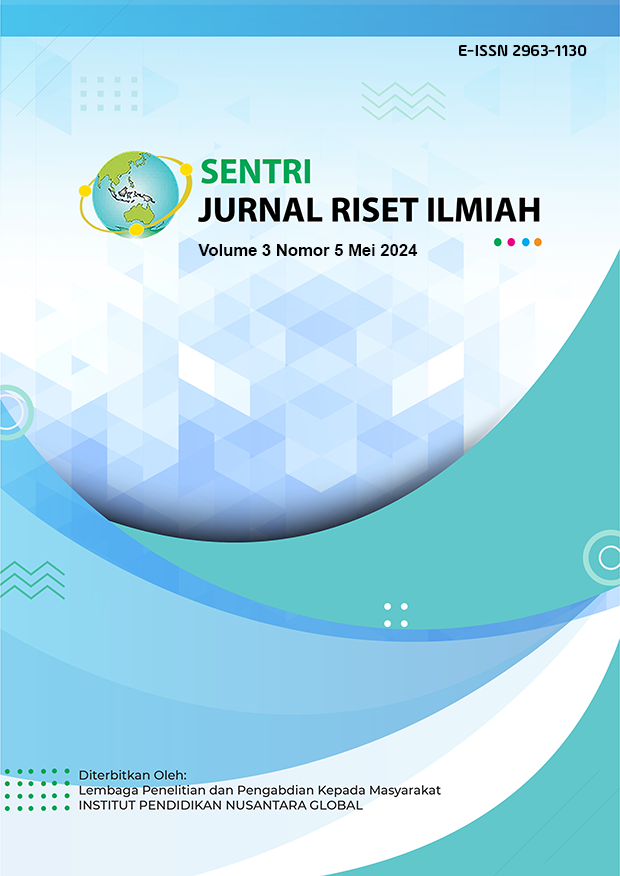SMARTPHONE ADDICTION LEVELS IN SCHOOL-AGE CHILDREN AFTER THE COVID-19 PANDEMIC IN RURAL AREA
DOI:
https://doi.org/10.55681/sentri.v3i5.2678Keywords:
smartphone addiction, school-age children, covid-19Abstract
The level of dependence of children on smartphones increased during the Covid-19 pandemic to 47.5%. The average smartphone use time for school-age children is 6.85 hours a day. Meanwhile, the ideal screen time for school-age children is no more than 2 hours/day. Smartphone addiction is a growing problem in children with adverse physical, psychological, and social health conse-quences. The purpose of the study was to see the levels of smartphone addiction in school-age children after the Covid-19 pandemic in rural area of Indonesia. This study used a cross-sectional descriptive design. The research subjects were school-aged children at "X" Elementary School (N=114), total sampling. Data collection was carried out using the Indonesian version of the Smartphone Addiction Scale (SAS) instrument which is valid and reliable. Data were analyzed using descriptive statistics. The smartphone addiction levels were 13.2% for low addiction, 77.2% for moderate addiction, and 9.6% for severe addiction. Item 4 SAS, which contains a statement of feeling happy when using a smartphone gets the highest score. The positive anticipation dimension is the most dominant with the highest score. The level of smartphone addiction after the Covid-19 pandemic among school-age children in this study was dominated by moderate smartphone addiction. The role of parents, teachers, health workers, and the government is an important key to reducing smartphone addiction incidents in school-age children in the future.
Downloads
References
Aljomaa, Suliman S., Mohammad F. Mohammad, Ismael S. Albursan, Salaheldin F. Bakhiet, and Adel S. Abduljabbar. 2016. “Smartphone Addiction among University Students in the Light of Some Variables.” Computers in Human Behavior 61, no. August (August): 155–64. https://doi.org/10.1016/J.CHB.2016.03.041.
Amalia, Reza Fajar, and Achir Yani Syuhaimie Hamid. 2020. “Adiksi Smartphone, Kesehatan Mental Anak, Dan Peranan Pola Asuh.” Jurnal Ilmu Keperawatan Jiwa 3, no. 2: 221–40.
Antang, Nadya Inara Oktavirna. 2021. “Gambaran Perilaku Kecanduan Smartphone Pada Mahasiswa.” Repository Universitas Sanata Dharma Yogyakarta, 86. http://repository.usd.ac.id/39235/2/159114026_full.pdf.
APJI. 2022. “Hasil Survey Profil Internet Indonesia 2022.” Apji.or.Od, no. June. apji.or.id.
APJII. 2019. “Hasil Survei Penetrasi Pengguna Internet Indonesia Tahun 2018.” Apjii, 51. https://databoks.katadata.co.id/datapublish/2020/11/11/jumlah-pengguna-internet-di-indonesia-capai-1967-juta, diakses pada tanggal 16 September 2021pukul 4.52 WIB.
Aulia, Devy Syafa. 2019. Faktor – Faktor Yang Mempengaruhi Adiksi Smartphone Pada Remaja.
Basit, Abdul. 2022. “HUBUNGAN AKTIVITAS FISIK DENGAN STATUS GIZI PADA ANAK SEKOLAH SELAMA MASA PANDEMI COVID-19 DI SDN KARANG MEKAR 9 KOTA BANJARMASIN.” Jurnal Inovasi Penelitian 39, no. 1: 149–64.
Bhattacharyya, Dr Ranjan. 2021. “Addiction to Modern Gadgets and Technologies Across Generations.” Eastern Journal of Psychiatry 18, no. 2: 27–37. https://doi.org/10.5005/ejp-18-2-27.
Bian, Mengwei, and Louis Leung. 2015. “Linking Loneliness, Shyness, Smartphone Addiction Symptoms, and Patterns of Smartphone Use to Social Capital.” Social Science Computer Review 33, no. 1: 61–79. https://doi.org/10.1177/0894439314528779.
Bröhl, Christina, Peter Rasche, Janina Jablonski, Sabine Theis, Matthias Wille, and Alexander Mertens. 2018. “Desktop PC, Tablet PC, or Smartphone? An Analysis of Use Preferences in Daily Activities for Different Technology Generations of a Worldwide Sample.” Lecture Notes in Computer Science (Including Subseries Lecture Notes in Artificial Intelligence and Lecture Notes in Bioinformatics) 10926 LNCS, no. January: 3–20. https://doi.org/10.1007/978-3-319-92034-4_1.
Broto, Gatot S. Dewa. 2014. “Kementerian Komunikasi Dan Informatika.” 2014. https://www.kominfo.go.id/content/detail/3834/siaran-pers-no-17pihkominfo22014-tentang-riset-kominfo-dan-unicef-mengenai-perilaku-anak-dan-remaja-dalam-menggunakan-internet/0/siaran_pers.
ChildWise. 2020. “Childhood 2020: New Independent Report,” 1–3. www.childwise.co.uk.
Ching, Siew Mooi, Anne Yee, Vasudevan Ramachandran, Sazlyna Mohd Sazlly Lim, Wan Aliaa Wan Sulaiman, Yoke Loong Foo, and Fan Kee Hoo. 2015. “Validation of a Malay Version of the Smartphone Addiction Scale among Medical Students in Malaysia.” PLoS ONE 10, no. 10: 1–11. https://doi.org/10.1371/journal.pone.0139337.
Chłoń-Domińczak, Agnieszka, Łukasz Sienkiewicz, and Katarzyna Trawińska-Konador. 2014. “The Development of the Polish Qualifications Framework as an Application of Knowledge Management in Public Policy.” Proceedings of the European Conference on Knowledge Management, ECKM 1: 214–22.
Damayanti, Ratih, Indah Lutfiya, and Neffrety Nilamsari. 2019. “Upaya Peningkatan Pengetahuan Tentang Gizi Seimbang Pada Anak Usia Sekolah Dasar.” Journal of Community Service and Engagements 01, no. 1: 28–33.
Farhud, Dariush D., Maryam Malmir, and Mohammad Khanahmadi. 2014. “Happiness & Health: The Biological Factors- Systematic Review Article.” Iranian Journal of Public Health 43, no. 11: 1468–77.
Fathya, Rita, Kartika Sari, and Marty Mawarpury. 2020. “Level of Smartphone Addiction on Banda Aceh Society” 16.
Fischer-Grote, Linda, Oswald D. Kothgassner, and Anna Felnhofer. 2019. “Risk Factors for Problematic Smartphone Use in Children and Adolescents: A Review of Existing Literature.” Neuropsychiatrie 33, no. 4 (December): 179. https://doi.org/10.1007/S40211-019-00319-8.
Haynes, Trevor. 2018. “Dopamine, Smartphones & You: A Battle for Your Time - Science in the News.” 2018. https://sitn.hms.harvard.edu/flash/2018/dopamine-smartphones-battle-time/.
Hickson, Sarah. 2022. “Therapeutic Play and Instilling Competence in the School-Aged Child.” Integrating Therapeutic Play Into Nursing and Allied Health Practice, 113–22. https://doi.org/10.1007/978-3-031-16938-0_9.
IDAI. 2014. “IDAI | Keamanan Menggunakan Internet Bagi Anak.” 2014. https://www.idai.or.id/artikel/seputar-kesehatan-anak/keamanan-menggunakan-internet-bagi-anak.
Jennifer, I. H.M. 2018. “Social Implications of Children’s Smartphone Addiction: The Role of Support Networks and Social Engagement.” Journal of Behavioral Addictions 7, no. 2: 473–81. https://doi.org/10.1556/2006.7.2018.48.
Krach, Sören, Frieder M. Paulus, Maren Bodden, and Tilo Kircher. 2010. “The Rewarding Nature of Social Interactions.” Frontiers in Behavioral Neuroscience 4, no. MAY (May). https://doi.org/10.3389/FNBEH.2010.00022/FULL.
Kurniawan, I.G.Y., I.M. Rustika, and L.N.A Aryani. 2016. “Uji Validitas Dan Reliabilitas Modifikasi Smartphone Addiction Scale Versi Bahasa Indonesia.” Medicina 47, no. 3: 1–9.
Kwon, Min, Joon Yeop Lee, Wang Youn Won, Jae Woo Park, Jung Ah Min, Changtae Hahn, Xinyu Gu, Ji Hye Choi, and Dai Jin Kim. 2013. “Development and Validation of a Smartphone Addiction Scale (SAS).” PLoS ONE 8, no. 2. https://doi.org/10.1371/journal.pone.0056936.
Lava. 2018. “Basic Needs of Smartphones - Why a Smartphone Is Necessary?” 2018. https://www.lavamobiles.com/blog/basic-needs-of-smartphones/.
Lemola, Sakari, Nadine Perkinson-Gloor, Serge Brand, Julia F. Dewald-Kaufmann, and Alexander Grob. 2015. “Adolescents’ Electronic Media Use at Night, Sleep Disturbance, and Depressive Symptoms in the Smartphone Age.” Journal of Youth and Adolescence 44, no. 2: 405–18. https://doi.org/10.1007/s10964-014-0176-x.
Mehrnaz, Moattari, Moattari Farahnaz, Kaka Gholamreza, Kouchesfahani Homa Mohseni, Sadraie Seyed Homayoon, and Naghdi Majid. 2018. “Smartphone Addiction, Sleep Quality and Mechanism.” International Journal of Cognition and Behaviour 1, no. 1 (December). https://doi.org/10.23937/IJCB-2017/1710002.
Mohamed, Sayeda Mohamed, and Mona Hamdy Mostafa. 2020. “Impact of Smartphone Addiction on Depression and Self-Esteem among Nursing Students.” Nursing Open 7, no. 5: 1346–53. https://doi.org/10.1002/nop2.506.
Mokhtarinia, Hamid Reza, Maryam Heydari Torkamani, Ozra Farmani, Akbar Biglarian, and Charles Philip Gabel. 2022. “Smartphone Addiction in Children: Patterns of Use and Musculoskeletal Discomfort during the COVID-19 Pandemic in Iran.” BMC Pediatrics 22, no. 1: 4–11. https://doi.org/10.1186/s12887-022-03748-7.
Mutiara, Afni. 2022. “Transformasi Digital Pada Masa Pandemi Covid-19.” 2022. https://digitalbisa.id/artikel/transformasi-digital-pada-masa-pandemi-covid-19-1Bfb4.
Park, Jeong Hye. 2020. “Smartphone Use Patterns of Smartphone-Dependent Children.” Child Health Nursing Research 26, no. 1: 47–54. https://doi.org/10.4094/chnr.2020.26.1.47.
Rahmawati, Nurfitri, Herlina Herlina, and Yesi Hasneli N. 2021. “Gambaran Ketergantungan Gadget Pada Anak Usia Sekolah.” Jkep 6, no. 2: 135–45. https://doi.org/10.32668/jkep.v6i2.445.
Sohn, Sei Yon, Philippa Rees, Bethany Wildridge, Nicola J. Kalk, and Ben Carter. 2019. “Prevalence of Problematic Smartphone Usage and Associated Mental Health Outcomes amongst Children and Young People: A Systematic Review, Meta-Analysis and GRADE of the Evidence.” BMC Psychiatry 21, no. 1: 1–10. https://doi.org/10.1186/s12888-020-02986-2.
StatCounter. 2022. “Desktop vs Mobile vs Tablet Market Share Worldwide | Statcounter Global Stats.” 2022. https://gs.statcounter.com/platform-market-share/desktop-mobile-tablet.
Sumiyarini, Retno, and Amini Yuliyani. 2022. “Kecanduan Smartphone Dan Stres Akademik Di Masa Pandemi : Sebuah Studi Potong Lintang.” Smart Society Empowerment Journal 2, no. 2: 57. https://doi.org/10.20961/ssej.v2i2.62758.
Vyas, Dhara Yagnang. 2021. “Effect of Smartphone Addiction among School Going Children ( 8-12 Years ) during COVID-19 Pandemic,” no. October.
Wigmore, Ivy. 2018. “What Is Smartphone Addiction (Cell Phone Addiction)?” 2018. https://www.techtarget.com/whatis/definition/smartphone-addiction-cell-phone-addiction.
Zaini, Muhammad, and Soenarto Soenarto. 2019. “Persepsi Orangtua Terhadap Hadirnya Era Teknologi Digital Di Kalangan Anak Usia Dini.” Jurnal Obsesi : Jurnal Pendidikan Anak Usia Dini 3, no. 1: 254. https://doi.org/10.31004/obsesi.v3i1.127.
Downloads
Published
How to Cite
Issue
Section
License
Copyright (c) 2024 Revita Nur Istiqomah Muslim, Kurniawan Yudianto, Umar Sumarna, Mamat Lukman, Hendrawati Hendrawati, Tuti Pahria

This work is licensed under a Creative Commons Attribution-ShareAlike 4.0 International License.









